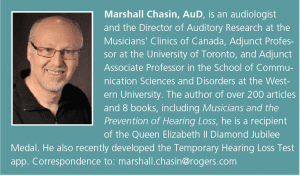Back to Basics | May 2018 Hearing Review
I receive many questions from instrumental musicians, vocalists, and performing artists about issues relating to how they should practice. A particularly common question is “How can I modify a room in my house so that my vocal practice doesn’t drive my dog crazy?”
The adage, “Some is good, too much is bad,” comes to mind.
Even if one has an infinite supply of funds, the proper answer is nota sound-treated booth! There are many manufacturers of sound-treated booths that are used for audiometric testing, and these tend to be enclosures with high-density/metal walls that can assure low ambient sound levels, especially in the mid- and higher frequency regions. And, while these sound-treated booths may make your dog happy, they can pose problems.
When we play a musical instrument or sing, much of what we hear are reflections off the walls, ceiling, floor, and other structures in a room. Too much echo can be as bad as too little. The correct balance of initial sound, followed by reflected sound, is the goal.
Assuming that we don’t have funds for an acoustical engineer to come in to measure the ratio of early reflections to late reflections—and we just want a room that can be thrown together rather quickly using materials we already have—there are four basic acoustic principles that can guide your actions: A) Have at least one reflecting wall or surface; B) The greater the density of the material, the better its sound attenuation characteristics are; C) Low-frequency sounds love to leak out of small gaps, and D) Don’t have parallel surfaces. Using a combination of these four principles, along with experimentation, may yield a practice room that is both acceptable and relatively inexpensive.
Principle A: Have at least one reflection wall or surface. This is a long-standing principle in sound recording that is sometimes referred to as the LEDE concept. LEDE stands for Live End; Dead End. The musician will generate their sound/vocal output aiming towards the Live End, which is a reflective surface such as a wall that is devoid of pictures, wallpaper, or other absorbing materials. The other wall(s) can have absorbing materials such as heavy drapes (which may be pulled back so that the room can be used for other purposes, at other times) or even permanently installed acoustic panels that can be purchased relatively inexpensively.
This idea is often employed in a classroom. For example, at the younger elementary levels, where the children may have a cloakroom for their coats and backpacks, the doors to these closets can be left open. Although this may not look “neat,” the improved acoustics (and lessened reflections) can be well worth the effort. Three dimensional artwork on the walls, such as decorated egg cartons, may also help to lessen unwanted reflections.
Principle B: The greater the density, the better its sound attenuation characteristics are. Heavier, dense wall coverings are better at sound isolation than lighter, less-dense structures. As a general rule, the denser a material is, the more expensive it is, so this will be a natural upper limit on the effectiveness of any room treatment. Practically, it tends to be better if there are a number of lower density structures (such as drapes and pictures) than one dense structure.
Principle C: Low-frequency sounds love to leak out of small gaps. The space beneath the doorway can be a major difference in isolating yourself from your dog (and others). Small spaces such as this can allow the longer-wavelength low-frequency sounds to escape from the practice room. This may be problematical for instrumental musicians, but not as much for vocalists. Placing a towel at the base of a door can help to solve this unwanted leakage. But…ensure that the ventilation in the room is adequate! You do not want to create an artificial situation where air exchange in the room is compromised. Vocalists need not worry about this since most of their vocal energy is in the higher frequency ranges and leaks beneath doors should not pose a significant issue. (And obviously vocalists should drink plenty of water.)
Principle D: Don’t have parallel surfaces. Reflections can only build up and become a problem if two surfaces are in parallel with each other. Of course, most rooms have the ceiling in parallel to the floors, and opposing walls tend to be parallel with each other. I have seen many sound rooms over the years where walls are slightly off, at 90° from each other. It looks odd, but sounds pretty good.
Short of constructing a new “false” wall in your house, the use of portable “office dividers” can be useful, especially if at least one wall has them angled slightly so that they are not perfectly parallel to the opposing wall.
The Bottom Line
Using some elements from each of these four acoustical principles, depending on the budget and the ultimate goal of sound isolation, can assist in creating an environment that, while not perfect, would be better than many current practice rooms.
Adapted from the author’s March 20, 2018 blog at HearingHealthMatters.com
Original citation for this article: Chasin M. A vocalist wants a quiet space at home to practice. Hearing Review. 2018;25(5):10.
Image: © Nejron | Dreamstime






